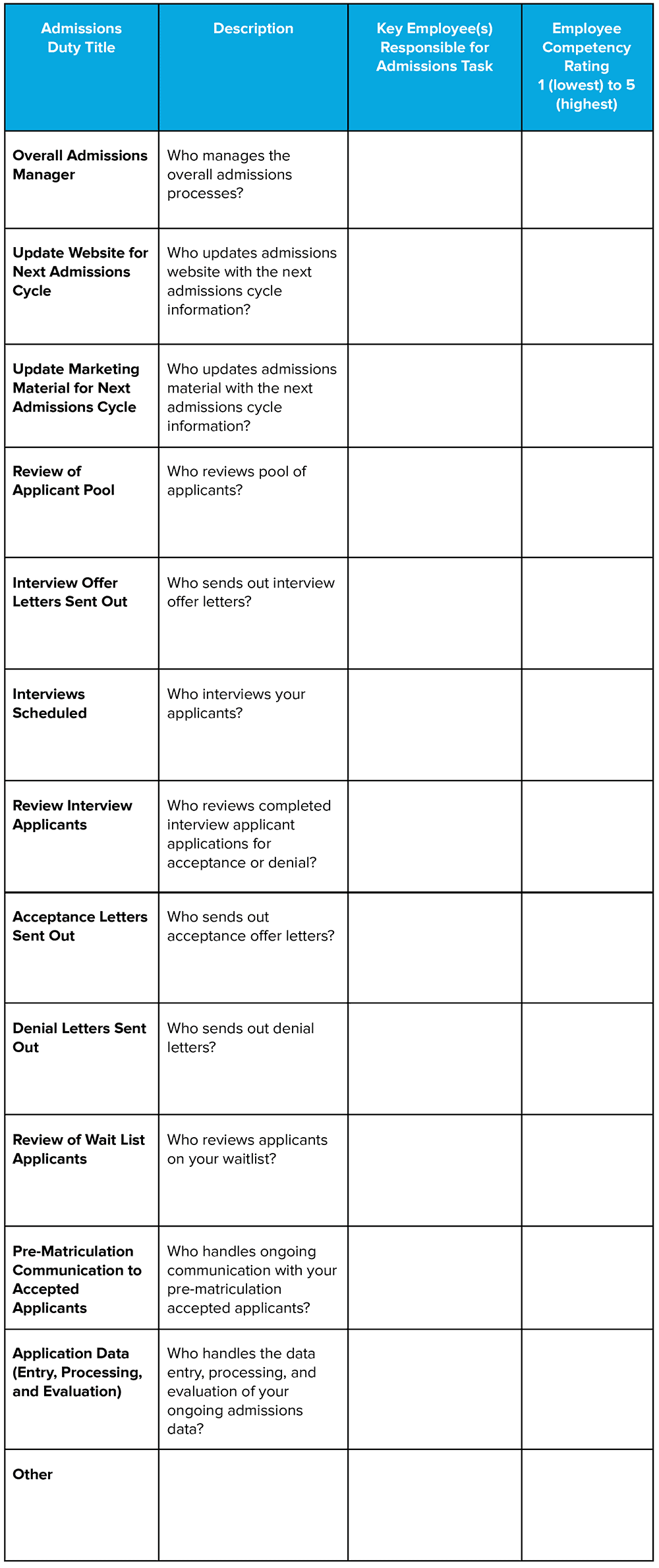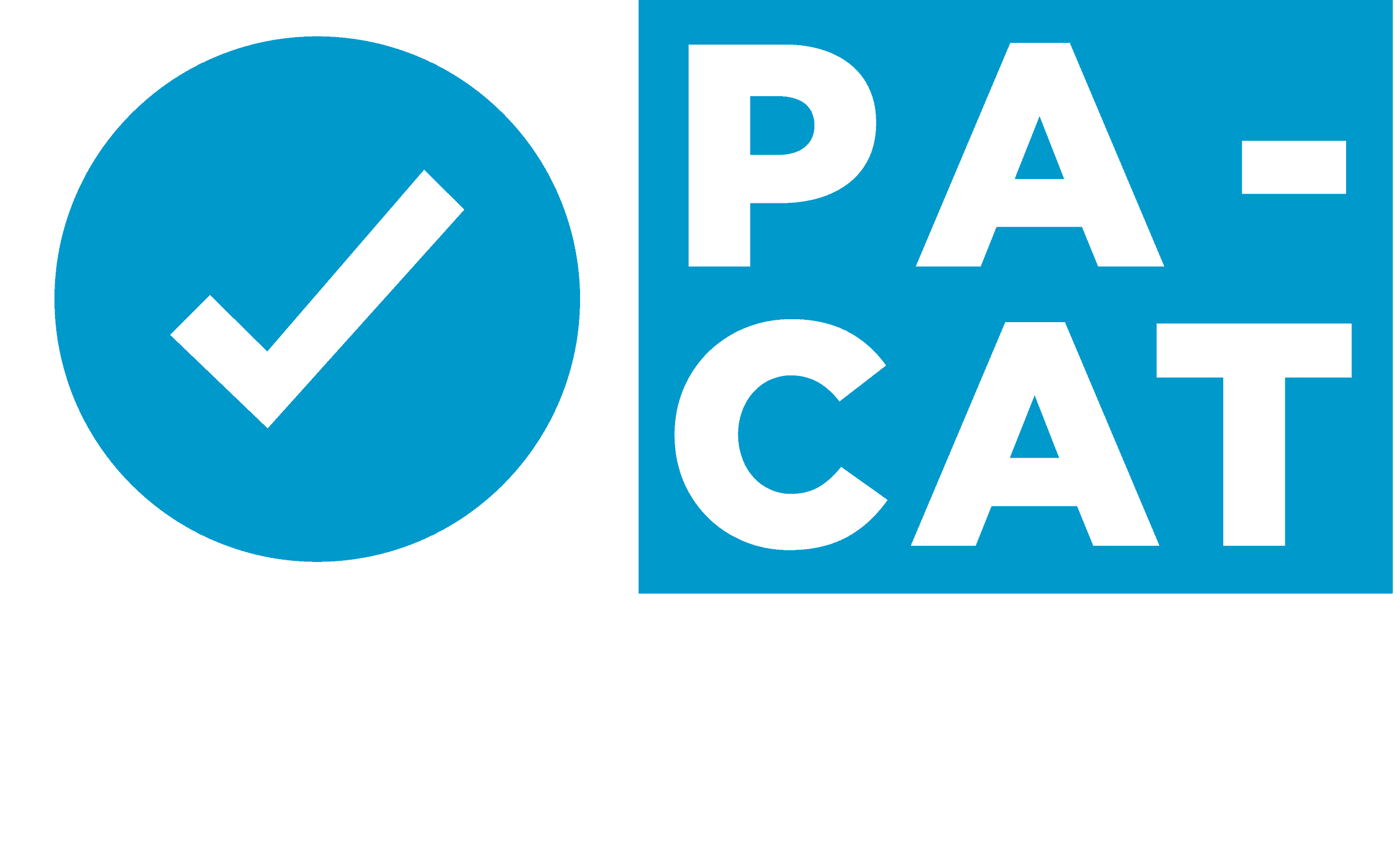ISSUE 13
Managing PA Admissions Personnel Part 2: Key Admissions Personnel and Skill Set Rating
By Jim Pearson and Dr. Scott Massey
Welcome back to PA Admissions Corner, as we continue our series on Managing PA Admissions Personnel. In the previous Issue, you compared your program’s admission duties timeline to the national average, and we suggested what can be done to stay competitive and focus your staff on the areas that need the most effort.
Now that you know when your program’s admissions duties should take place, let’s talk about getting that work done. Opening interviews two months earlier is a great idea, but it won’t happen if you don’t have the staff necessary to review the applications, make the contacts, send the letters, and set up the appointments. How you assign your admissions department’s key duties is extremely important, but first, you need a clear understanding of who your key admission personnel are— of their duties and skill sets.
The Roles of Admissions Personnel
Each member of an efficient admissions team knows their role in the process. Adopt simple descriptions of process roles to cut right to the chase.
- Public Relations (PR)—Makes prospective students feel welcome and fosters excitement about your program. Appoint one person as the face of your program: phone inquiries, town halls, and communications through CASPA once an applicant has applied to the program.
- CASPA Monitoring—Monitors CASPA to facilitate frequent communication with applicants.
- Application Data Analysis—Reviews the data on the application and transfers it to the appropriate rubrics.
- Pre-Interview Outreach—Reaches out with invitations for interviews and ensures that applicants have the right information at the right time.
- Interview Logistics—Facilitating logistics for the interview process can be highly complex with multiple moving parts. You don’t want applicants to suspect any chaos or disorganization within your program; a department that scrambles to organize interviews probably isn’t a great choice for an education.
- Post-Interview Follow-up—Reaches out after interviews and offers applicants seats.
- Post-Acceptance Letter Management—Communicates with applicants between the time of deposit and the date of matriculation, providing updates about the program and keeping them excited about their career choice.
- Troubleshooting Management—Monitors last-minute melt in the system. We have seen applicants withdraw their seats on the day of orientation, usually after receiving an offer at their most preferred program. Communicating with applicants high on the waitlist and facilitating their rapid enrollment is essential to avoid empty seats.
Your personnel handling key admission duties will have a significant impact on how successfully your program reaches its goals. A self-assessment on key personnel skill sets will provide a snapshot of areas needing further evaluation or adjustments.
You will need to list all key admissions personnel in relation to the key admission duties listed in the Key Admissions Duty Timelines table and rate their skill set (competency).
Key Admissions Personnel and Skill Set Rating
List and rate your current admissions staff (download & print table below) in relation to your PA program’s key admissions workflow duties:
- All data requested in this table is only for your PA program’s current application cycle and your current admissions staff.
- Some PA programs have revolving non-staff who help with admissions interviews from other graduate medical programs. For those non-staff, list who currently is helping your program from other graduate medical programs and rate their competency.
- When rating individual competency, the rating should only reflect the single duty/task being evaluated. If you have an assistant admissions director who is extremely competent in their overall tasks, rate that skill set highly; if they are not very competent in data management, however, rate that skill set lower.
- Employees often fall into responsibilities for certain duties (including important admissions tasks) regardless of their individual competence.
- Later, you will use these ratings to help determine adjustments in your admissions staffing duties to boost the outcomes of your admissions department.

It’s not always easy to evaluate and rate colleagues’ abilities, especially when they are not as skilled in certain areas as we’d like. Be as fair and honest in your evaluations as possible; when appropriate, have someone else rate your colleagues with you and compare the results. The more honest you are in these evaluations, the easier it will be to make the necessary changes to strengthen your personnel, which will improve admissions outcomes.
After reviewing the evaluations and ratings of key admissions duties personnel, do you have the right employee(s) assigned to each key task? If not, how can you better align your employees in their admissions duties? What additional training might be needed?
NEXT TIME…
In the third and final installment on Managing PA Admissions Personnel, we’ll outline and answer questions commonly asked by PA admissions programs. How can you handle large applicant pools? Or supplement your staff? Are there ways to streamline your admissions process to select the best applicants for your program?
To your admissions and program success,
Jim Pearson, CEO
Exam Master
Dr. Scott Massey Ph.D., PA-C
Scott Massey LLC
Exam Master supports Physician Assistant Educational Institutions with the following services:
- Admissions Support Services
- PA-CAT Admissions Exam
- Pre-Matriculation Program
- Admissions Consulting
- Student Progression
- Student Success Study Skills Program
- Data Analytics
- Accreditation Support
- Board Preparation
- Emory Clinical Review Program
- PANCE Board Review Program
For information on any of the above products and/or services, contact Jim Pearson.

